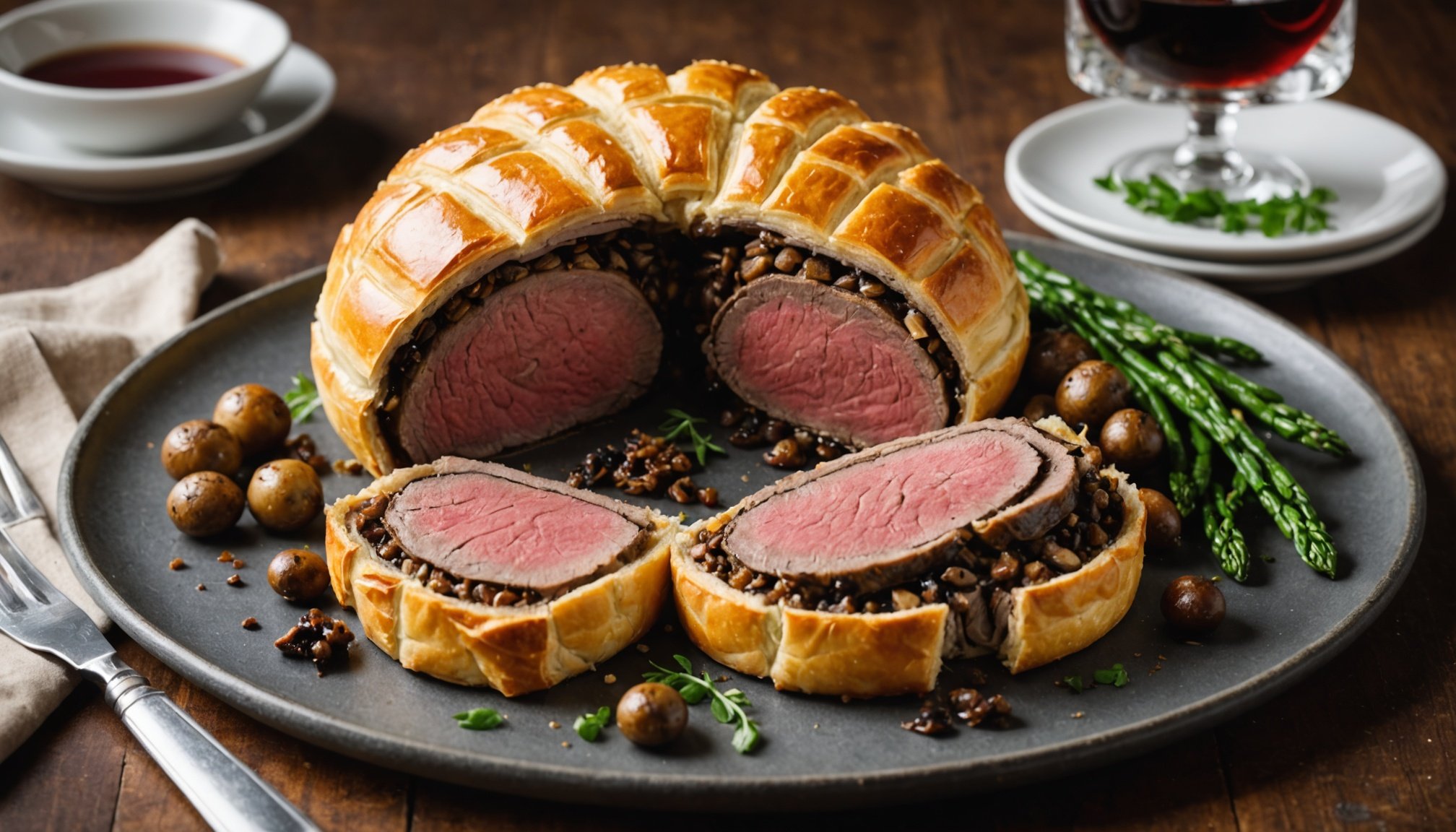Constructing the Beef Wellington
Creating a perfect Beef Wellington involves more than just skill; it’s an art. Key to the assembly of a successful dish is precision attention to detail. To begin, it’s essential to start with a well-seared piece of high-quality beef. This not only locks in flavour but ensures an even cook throughout. Wrap this carefully in layers of mushroom duxelles and ham for depth in your palate experience.
Assembly Techniques
Those delicate layers need a strong foundation. This usually involves pastry techniques. The temperature and thickness of the pastry play a significant role. Too thick, and it overpowers the filling; too thin, and it risks breaking. Roll the pastry confidently, ensuring an even thickness for the best results.
In parallel : Savor the Taste of Summer: Crafting Traditional English Summer Pudding with Fresh Berries – A Comprehensive Guide
Avoiding Common Pitfalls
One significant hurdle in Beef Wellington assembly is preventing the pastry from becoming soggy. A tip is ensuring all components are cooled appropriately before assembly. Additionally, lightly dusting flour on the pastry helps absorb any excess moisture. Allowing these techniques to guide you provides confidence in achieving a perfect texture, maintaining the iconic crisp layer encasing the succulent beef within. Engage with these steps to elevate your culinary experience and craft a delightful Beef Wellington.
Introduction to Beef Wellington
Beef Wellington is a dish with rich history, believed to have been named after Arthur Wellesley, the Duke of Wellington, who gained fame after the Battle of Waterloo. This gourmet recipe symbolizes luxury and requires honed culinary skills, making it a status dish in fine dining.
Also to see : Unveiling the enigma: what’s in the le creuset mystery box?
Mastering gourmet recipes like Beef Wellington is crucial for any aspiring chef, as it showcases technical prowess and understanding of complex flavour pairings. At its heart, Beef Wellington is a sophisticated assembly of high-quality beef wrapped in savoury mushroom duxelles and encased in a delicate pastry. The harmony between the beef, mushrooms, and pastry is what elevates this dish into the realm of culinary excellence.
Historical records suggest the primary intention of the dish was to coat meat with ingredients that sealed in moisture and added flavour. Over time, the recipe evolved, but the core concept remains—to create a luxurious dining experience through meticulous attention to detail. Each component of the recipe—whether it’s the searing of the beef, the preparation of the duxelles, or the pastry technique—plays a pivotal role in the ultimate success of the dish.
Essential Ingredients for Beef Wellington
Creating an exceptional Beef Wellington is deeply rooted in selecting the finest components. The heart of this gourmet recipe is the high-quality beef it encases. For the ultimate flavour and tenderness, choose a cut like beef tenderloin, known for its rich texture.
Equally pivotal is the mushroom duxelles. This finely chopped blend of mushrooms enhances the recipe’s flavour profile, offering a savoury, earthy complement to the beef. To achieve the best results, opt for fresh, high-quality mushrooms. Their freshness directly affects both the duxelles’ taste and moisture content, which are critical factors in maintaining the pastry’s desired crispness.
Finally, the pastry serves as an essential barrier, keeping all elements intact and flavour-rich. Selecting a sturdy yet tender pastry, such as puff pastry, ensures a golden, flaky exterior. With these ingredients harmonising perfectly, your Beef Wellington is set to transform into an exquisite masterpiece.
These foundational selections lay the groundwork for each subsequent step, promising a satisfying tasting experience for all who indulge in this classic dish.
Preparing Savory Mushroom Duxelles
Creating the perfect mushroom duxelles is an essential step in crafting a remarkable Beef Wellington. Emphasising the right flavor profiles can elevate this component from ordinary to extraordinary.
Cleaning and Chopping Mushrooms
Before delving into the duxelles recipe, ensure your mushrooms are meticulously cleaned. Wipe them with a damp cloth rather than rinsing them under water to maintain optimal texture. Finely chop the mushrooms; this uniformity is crucial for even cooking and achieving the desired consistency. Integrating herbs like thyme or tarragon can enhance the earthy notes of your duxelles.
Cooking the Duxelles
To craft the savoury duxelles, sauté the finely chopped mushrooms in butter. Maintaining moisture control is paramount; cook until most liquid evaporates, ensuring a firm but tender texture. Incorporating a splash of white wine or seasoning with salt and pepper can further enrich the flavour.
Cooling and Storing Duxelles
Before incorporating them into your Beef Wellington, allow the duxelles to cool completely. Proper cooling prevents pastry sogginess. Store any leftovers in an airtight container for future use. Duxelles should visually appear dry and aromatic, signalling readiness for assembly.
Cooking Methods for Beef Wellington
Crafting the perfect Beef Wellington requires understanding various cooking techniques. These methods ensure the beef is both well-cooked and delectably juicy. Roasting methods are the most popular choice, typically involving an oven preheated to a precise temperature. This method achieves an even cook and preserves the moisture in the beef.
Maintaining the correct temperature guide is crucial to avoid an over or undercooked dish. Generally, the beef should be cooked until it reaches an internal temperature of around 125°F (52°C) for medium-rare. To achieve this, you should ideally use a meat thermometer. It’s inserted into the thickest part of the Beef Wellington to accurately monitor the temperature without disrupting the pastry’s structure.
Monitoring doneness without cutting into the pastry is another critical skill. With experience, cooks learn to gauge readiness by external cues such as the pastry’s colour and texture. Techniques like gently pressing on the pastry to feel its firmness can also help infer the internal state of the beef. These methods enhance your culinary skills and guarantee an exquisite Beef Wellington.
Troubleshooting Beef Wellington Issues
Creating the perfect Beef Wellington can sometimes come with challenges. Recognising and rectifying these common problems ensures success with this gourmet recipe.
Common Mistakes
Soggy pastry is a frequent issue, often caused by insufficient cooling of ingredients or overly wet mushroom duxelles. To improve, allow all components to cool entirely before assembly. Another challenge is ensuring the beef’s proper doneness. An internal temperature too low leads to undercooked meat, while too high results in dryness. Monitoring with a precise thermometer prevents this issue.
Solutions and Adjustments
When experiencing issues with different ovens or setups, adjustments are key. For inconsistent oven temperatures, rotating the Beef Wellington halfway through cooking can promote even baking. If pastry browning occurs too quickly, tent the Wellington with aluminium foil to safeguard against burning.
Culinary Hacks
Small kitchen hacks can make a significant difference. For extra flavour, consider brushing the pastry with a beaten egg mixed with a dash of cream for added sheen and richness. These strategies drive culinary confidence, allowing home cooks to triumph over technical hurdles and savour a successful dish.
Presentation and Serving Suggestions
Plating techniques play a critical role in showcasing your Beef Wellington. Ensuring each slice maintains its structural integrity on the plate is key. Use a sharp, serrated knife for clean cuts. Present the slices attractively by fanning them out slightly.
Innovative Plating Techniques
Creating visual appeal can be as simple as using garnishes such as finely chopped herbs or vibrant sauces. Carefully arrange these elements around the Beef Wellington to complement colors and enhance the overall presentation.
Serving Ideas
Pairing your Beef Wellington with suitable side dishes elevates the gourmet experience. Classic choices include creamy mashed potatoes or lightly sautéed greens like asparagus or spinach. These sides offer contrast yet support the dish’s rich flavours.
Setting an Elegant Dining Experience
To truly elevate the dining experience, consider the table setting. Elegant, simple tableware enhances focus on the Beef Wellington. Decant a red wine with depth and character to complement the meal. This attention to detail transforms a meal into a memorable occasion, showcasing both culinary skills and an eye for elegance.
Conclusion and Chef’s Tips
In the quest to master the perfect Beef Wellington, embracing expert advice can significantly elevate your culinary confidence. Consider these practical tips, designed to bolster your journey from preparation to presentation.
First, harness the power of thorough planning. Create a detailed timeline, accounting for each step, from preparing the mushroom duxelles to perfecting the pastry techniques. This foresight ensures efficiency and precision, crucial for a dish requiring multiple components.
Developing a keen sense for recognizing subtle cues is invaluable. Pay attention to the aromas and textures each element presents. For instance, well-prepared duxelles should be dry and aromatic, a telltale sign of readiness for assembly. These nuances contribute to mastering skills essential for a flawless outcome.
Encourage experimentation within the gourmet recipe framework. Variations in herbs or pastes can tailor the dish to personal tastes while maintaining its sophisticated core.
Finally, engage in frequent practice. This repetition hones skills, instilling culinary confidence. Over time, you’ll refine techniques, enhancing both the flavour and visual appeal of your Beef Wellington, ensuring it consistently delights your guests.



